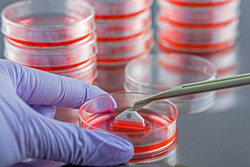How targeted stem cell research can tackle degenerative disease
A new study, supported in part by the EU-funded PLURIMES project, has achieved a breakthrough in the development of muscle cells in the lab. Published in the journal Nature Biotechnology, the study authors used stem cells to produce millimetre-long muscle fibres capable of contracting and multiplying in large numbers. Researchers hope that the new method will offer a better model for studying diseases and for testing out potential new treatment options. Better treatment is one of the key objectives of the PLURIMES project, which was launched in February 2014 to find new efficient methods of directing stem cells to become bone and muscle. In particular, the project is focusing on pluripotent stem cells, which have the potential to differentiate into almost any cell in the body. Researchers believe that harnessing the capacity of pluripotent stem cells will eventually lead to new treatments for various degenerative diseases such as muscular dystrophy. What makes the PLURIMES project so ambitious is the fact that it is specifically targeted at therapies for muscle, bone and cartilage. While skeletal muscle is one of the most abundant tissue types in the human body, it is difficult to produce in large quantities in the lab. Unlike other cell types such as heart cells and cells found in the gut, previous attempts to efficiently and accurately derive muscle cells from stem cells have not been successful. For PLURIMES, stem cell experts, genetic engineers, developmental biologists and cell therapy pioneers have been brought together in a cross-disciplinary collaborative effort to ensure that European researcher in this field remains at the cutting edge. A key goal of the project is to create a bioengineering platform for directing pluripotent stem cells into specific classes. Close working relationships between partners will be maximised through specialist workshops and laboratory exchange schemes. In order to achieve concrete results, the project will develop a toolbox of fluorescent reporters that can be used to track live cells and enable close analysis. New cutting edge bioengineering approaches will also be implemented. Through the involvement of SMEs, innovative culture systems will be optimised. These deliverables will enable the team to fully assess the capacity of pluripotent stem cells to mature into skeletal muscle, bone and cartilage. This will be tested in vitro and in vivo, and potency evaluated in pre-clinical disease models. The PLURIMES project, which will receive EU funding totalling EUR 6 million, is scheduled for completion in January 2018. The project is part of the European Commission’s HEALTH research programme, a larger European effort that recently granted a total of EUR 42 million for stem cell research projects. Throughout its project lifespan, PLURIMES aims to build close links with other consortia that have received EU funding, and closer collaborative relations have already been established with three other projects. A common theme running through all these projects is the focus on understanding the mechanisms of self-renewal and the differentiation of stem cell types suitable for various cell-based therapeutic applications. For further information please visit: PLURIMES https://www.plurimes.eu/
Countries
United Kingdom



